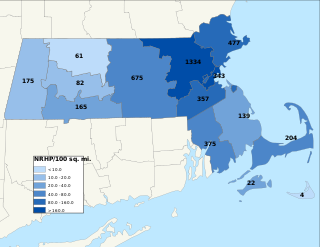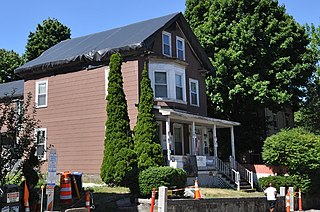
The Josiah Quincy House, located at 20 Muirhead Street in the Wollaston neighborhood of Quincy, Massachusetts, was the country home of Revolutionary War soldier Colonel Josiah Quincy I, the first in a line of six men named Josiah Quincy that included three Boston mayors and a president of Harvard University.

The Edmund Fowle House is a historic house and local history museum at 28 Marshall Street in Watertown, Massachusetts, USA. Built in 1772, it is the second-oldest surviving house in Watertown, and served as the meeting place for the Massachusetts Provincial Congress in the first year of the American Revolutionary War. Now owned by the local historic society, it was listed on the National Register of Historic Places in 1977.

The Macy–Colby House is a historically significant saltbox house at 257 Main Street in Amesbury, Massachusetts. It is a historic house museum and has been listed on the National Register of Historic Places since 2008. In addition to its great age, it is notable for its association with Thomas Macy, an early settler of Nantucket and the subject of a poem by John Greenleaf Whittier, and for its long association with the locally significant Colby family.

The National Register of Historic Places is a United States federal official list of places and sites considered worthy of preservation. In the state of Massachusetts, there are over 4,300 listings, representing about 5% of all NRHP listings nationwide and the second-most of any U.S. state, behind only New York. Listings appear in all 14 Massachusetts counties.

The Jackson Homestead, located at 527 Washington Street, in the village of Newton Corner, in Newton, Massachusetts, is an historic house that served as a station on the Underground Railroad before the Civil War.

The Old Ship Church is a Puritan church built in 1681 in Hingham, Massachusetts. It is the only surviving 17th-century Puritan meetinghouse in the United States. Its congregation, gathered in 1635 and officially known as First Parish in Hingham, occupies the oldest church building in continuous ecclesiastical use in the country. On October 9, 1960, it was designated a National Historic Landmark, and on November 15, 1966, it was added to the National Register of Historic Places.

This is a list of sites listed on the National Register of Historic Places in Cambridge, Massachusetts. This is intended to be a complete list of the properties and districts on the National Register of Historic Places in Cambridge, Massachusetts, United States. Latitude and longitude coordinates are provided for many National Register properties and districts; these locations may be seen together in an online map.

Joy Farm, also known as the E. E. Cummings House, is a historic farmstead on Joy Farm Road in the Silver Lake part of Madison, New Hampshire. It was designated a National Historic Landmark in 1971 in recognition for its place as the longtime summer home of poet E. E. Cummings (1894–1962).

Fort Washington, also known as Fort Washington Park, is a historic site at 95 Waverly Street in Cambridge, Massachusetts. It was built by soldiers of the Continental Army under the orders of George Washington in November 1775. It is the oldest surviving fortification from the American Revolutionary War and the only surviving fortification from the Siege of Boston. Fort Washington was placed on the List of Registered Historic Places in Massachusetts on April 3, 1973.

The Hubbard Park Historic District encompasses a residential development and park west of Harvard Square in Cambridge, Massachusetts. The area was originally the estate of Gardiner Hubbard, who had a 6-acre (2.4 ha) estate and house on nearby Brattle Street. In the 1880s Hubbard commissioned architects to build a ring of high quality homes around his mansion, which was demolished in 1939 and is now the site of Hubbard Park. The houses in this development are now located on Mercer Circle, Sparks Street, and Hubbard Park Road.

The Abraham Watson House is a historic house in Cambridge, Massachusetts.

The M. Clinton Bacon House, listed on the National Register of Historic Places as the Clifton Bacon House, is a historic house in Somerville, Massachusetts. Built in 1887, it is one of the city's finest examples of high-style Queen Anne Victorian architecture. It was listed on the National Register of Historic Places in 1989.

The Edmund Dwight House is a historic house at 5 Cambridge Street in Winchester, Massachusetts, straddling the town line with Arlington. It was built in 1858 in an Italianate style. It was one of the first and grandest country houses built in Winchester at a time when Boston businessmen were seeking to build such houses. Edmund Dwight, the wealthy businessman who was its first owner, was married to a great-granddaughter of Thomas Jefferson. The house's design is believed to be based loosely on that of Jefferson's Monticello. The house is sited for an expansive view of the Upper Mystic Lake. This residence was also home to Claude Shannon, the father of Information theory, and his wife Betty Shannon. While living there, they installed a chair lift that took the rider from the home down to the lake.

The Edmund Parker Jr. House is a historic house in Winchester, Massachusetts. The 2+1⁄2-story wood-frame house was built c. 1826, and is one of a few transitional Federal-Greek Revival houses in the town. It has the typical Federal plan of five bays wide and two deep, with a center entry framed by a Greek Revival portico. The house was built by Edmund Parker Jr., whose father was one of the first settlers in the area.

The Rev. Edmund Dowse House is a historic house in Sherborn, Massachusetts. The Greek Revival house was built in 1838 for the Rev. Edmund Dowse, the first pastor of the Evangelical Society, whose sone, William Bradford Homer Dowse, was a major benefactor of the town. The house was listed on the National Register of Historic Places in 1986.

The Dr. S. O. Richardson House is a historic house at 694 Main Street in Wakefield, Massachusetts, United States. Built in the late 1830s, this wood-frame house is one of the finest Greek Revival houses in Wakefield, and was the home of Dr. Solon O. Richardson, a locally prominent physician and real estate developer. The house was listed on the National Register of Historic Places in 1989.

The Michael Sweetser House is a historic house at 15 Nahant Street in Wakefield, Massachusetts. The 2+1⁄2-story timber-frame house was built c. 1755 by Michael Sweetser, an early settler of the area. It is traditionally Georgian in character, although its front door surround was added during Greek Revival period of the mid 19th century. One of the house's 19th century occupants was Paul Hart Sweetser, one of the founders of the Massachusetts Teachers Association and a locally active politician.

Edmund Burke is a bronze, full-length statue of British statesman, author, orator, political theorist, and philosopher Edmund Burke by British artist James Havard Thomas. The original statue is in Bristol, England, with a second cast in Washington, D.C. The statue in Washington, D.C., stands in Burke Park, at the intersection of 11th Street, L Street, and Massachusetts Avenue NW, on the southern border of the Shaw neighborhood. The statue was a gift from the Charles Wakefield, 1st Viscount Wakefield, on behalf of the Sulgrave Institution, an organization that wanted to celebrate United Kingdom–United States relations. One way the group did this was by exchanging statues and busts between the two countries.

The Edmund and Mary Ann Walworth Booth House is a historic building located in Anamosa, Iowa, United States. Raised in Longmeadow, Massachusetts, Edmund Booth contracted meningitis at age four and lost part of his hearing. By the time he was eight he was totally deaf. His wife Mary Ann was born in Connecticut and she was also four when she contracted meningitis, but lost all of her hearing at that time. Booth became an early educator for the deaf, and his wife was one of his pupils. They both relocated separately to Iowa in 1839, and married the following year. After spending five years in the California gold fields while his family remained in Iowa, Booth returned to Iowa and resumed farming. He was instrumental in establishing the Iowa School for the Deaf in 1855, and the Iowa Association of the Deaf in 1881. He became the association's president in 1884. Booth had a thirty-year career as the publisher and editor of the Anamosa Eureka. The Booth's had this brick Italianate house built in 1870. They lived here until Mary Ann died in 1898 and Edmund in 1905. It was listed on the National Register of Historic Places in 2001.

The Malcolm X—Ella Little-Collins House is a historic house at 72 Dale Street in the Roxbury section of Boston, Massachusetts. Built in 1874, it was for many years home to Ella Little-Collins, a prominent local civil rights activist, and was home to her younger brother Malcolm X during his later teenage years. During this period Malcolm X was exposed to Islam, beginning his path to involvement in the Nation of Islam. The house was listed on the National Register of Historic Places in 2021, at which time it was still owned by the Collins family.























